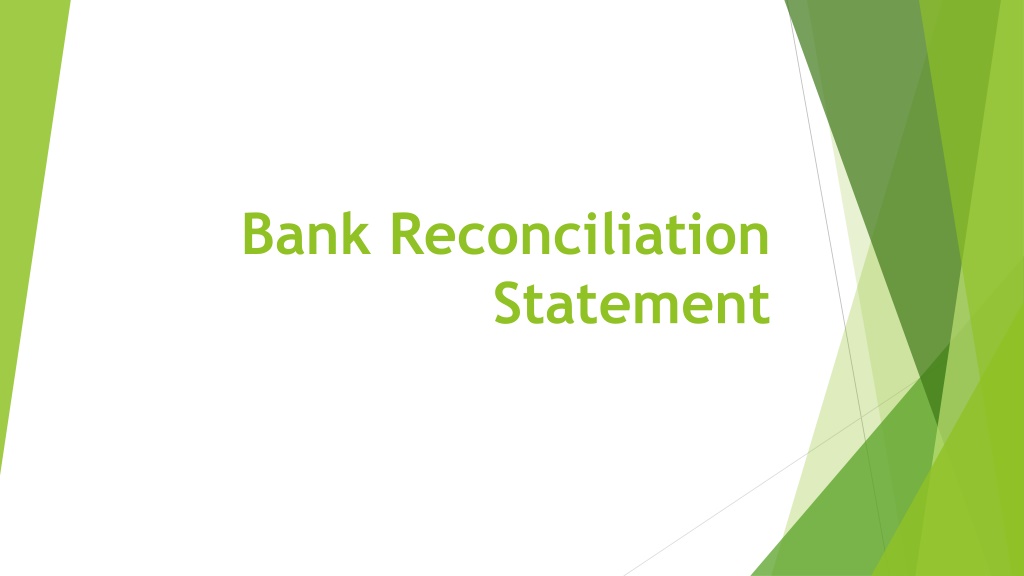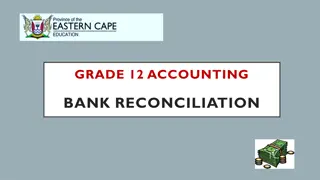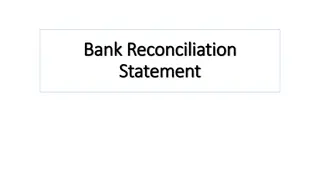Understanding Bank Reconciliation Statements
A Bank Reconciliation Statement is a crucial record book ensuring the accuracy between a company's cash book and bank balance. It helps identify differences caused by timing discrepancies, errors, and various transactions. By preparing this statement, discrepancies can be explained and reconciled effectively.
Download Presentation

Please find below an Image/Link to download the presentation.
The content on the website is provided AS IS for your information and personal use only. It may not be sold, licensed, or shared on other websites without obtaining consent from the author. Download presentation by click this link. If you encounter any issues during the download, it is possible that the publisher has removed the file from their server.
E N D
Presentation Transcript
Bank Reconciliation Statement
Bank Reconciliation Statement is a record book of the transactions of a bank account. This statement helps the account holders to check and keep track of their funds and update the transaction record that they have made. Bank Reconciliation statement is also known as bank passbook. The balance mentioned in the bank passbook of the statement must tally with the balance mentioned in the cash book. In the statement, all the deposit will be shown in the credit column and withdrawals will be shown in the debit column. However, if the withdrawal exceeds deposit it will show a debit balance (overdraft).
Importance of Bank Reconciliation Statement Generally while making a comparison between the company s cash book and bank balance, the balance does not tally. Therefore, it is important to determine the cause for the difference and display them in the bank reconciliation statement and then tally the two balances. The bank reconciliation statement helps in explaining the differences in the amount between the company s cash book and bank balance. The cash book and the bank passbook differences are caused by: The difference in timing recording the transactions: The difference in timing can be caused by many factors which are: Bank-issued cheque but not yet deposited for payment Paid cheque in the bank but yet not cleared Bank made direct debit from the customer s side Cheque/ amount deposited directly to the bank account Dividends and Interest collected by the bank Bank made direct payment from the customer s side Cheques deposited/bills discounted dishonoured
Errors made by the company or by the bank: In a few occasions, the error in two balances can be made from the bank side or in the company s cash book. Few errors are as follows: Errors made while registering the transaction by the company Errors made while registering the transaction by the bank
Types of Bank Reconciliation Statement The Bank Reconciliation Statement can be prepared in 2 ways: Documenting of bank reconciliation statement without adjusting the cash book balance. Filing of bank reconciliation statement after adjusting the cash book balance.
Steps to Prepare Bank Reconciliation Statement: First, the date on which the statement is recorded is mentioned. After which the balance displayed in the cash book is mentioned in the statement. Sometimes, the balance mentioned in the passbook can also be mentioned. The deposited cheques which are not collected are deducted. Then the cheques issued but the deposited for payment, but amount directly deposited in the bank account are recorded. All the transactions like overdraft interest, amount debited by the bank but not recorded in the cash book, cheques and bills dishonoured are deducted. All the credits and profit collected by the company and directly deposited in the bank is added. Adjustments of errors are made. Now the balance between the cash book and statement should be equal or the same.























